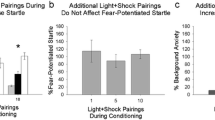Abstract
Animal data suggest that shock sensitization as well as aversive learning potentiates the acoustic startle reflex. The present experiment tested, whether this shock sensitization also occurs in human subjects and whether it precedes aversive conditioning. Sixty subjects viewed—prior to conditioning—a series of slides of different emotional contents including the to be conditioned stimuli (CSs). Afterwards, the experimenter attached the shock electrodes and initiated shock exposure. Then, subjects were randomly assigned to view a series of two slides, each for eight acquisition trials in which one slide was followed by a shock. Subsequently, extinction trials (12 for each slide) were administered. During preconditioning, acquisition, and extinction, startle probes occurred unpredictably during and between slide viewing. Preconditioning data replicated previous results by Lang and his associates, showing that the startle response magnitude is directly related to the affective valence induced by the slides. Shock exposure strongly facilitated the startle reflex magnitude. This shock sensitization was absent for the skin conductance response. Course of learning also varied for both response systems. The data suggest that startle reflex potentiation indexes the acquisition of an avoidance disposition, which is preceded by a general sensitization of the protective reflexes. Skin conductance learning follows arousal changes and is modulated by cognitive processes.
Similar content being viewed by others
References
Bradley, M.M., Cuthbert, B.N., & Lang, P.J. (1991). Startle and emotion: Lateral acoustic probes and the bilateral blink.Psychophysiology, 28, 285–295.
Brown, J.S., Kalish, H.I., & Farber, I.E. (1951). Conditioned fear as revealed by magnitude of the startle response to an auditory stimulus.Journal of Experimental Psychology, 41, 317–328.
Davis, M. (1986) Pharmacological and anatomical analysis of fear conditioning using the fear-potentiated startle paradigm.Behavioral Neuroscience, 100, 814–824.
Davis, M. (1989a). The role of the amygdala and its efferent projections in fear and anxiety. In P. Tyrer (Ed.),Psychopharmacology of anxiety (pp. 52–79). Oxford: Oxford University Press.
Davis, M. (1989b). Sensitization of the acoustic startle reflex by footshock.Behavioral Neuroscience, 103, 495–503.
Hamm, A.O., & Vaitl, D. (in press). Affective associations: The conditioning model and the organization of emotions. In N. Birbaumer & A. Öhman, (Eds.),The structure of emotion: Psychophysiological, cognitive, and clinical aspects. Toronto: Hogrefe & Huber Publishers.
Hamm, A.O., Greenwald, M.K., Bradley, M.M., Cuthbert, B.N., & Lang, P.J. (1991). The fear potentiated startle effect: Blink reflex modulation as a result of classical aversive conditioning.Integrative Physiological and Behavioral Sciences, 26, 119–126.
Hawkins, R.D., & Kandel, E.R. (1984). Is there a cell-biological alphabet for simple forms of learning?Psychological Review, 91, 375–391.
Hitchcock, J.M., Sananes, C.B., & Davis, M. (1989). Sensitization of the startle reflex by footshock: Blockade and lesions of the central nucleus of amygdala or its efferent pathway to the brainstem.Behavioral Neuroscience, 103, 509–518.
Lang, P.J., Bradley, M.M., & Cuthbert, B.N. (1990). Emotion attention, and the startle reflex.Psychological Review, 97, 377–395.
Lang, P.J., Bradley, M.M., & Cuthbert, B.N. (in press). A motivational analysis of emotion: Reflex-cortex connections.Phychological Science.
Lang, P.J., Greenwald, M.K., Bradley, M.M., & Hamm, A.O. (in press). Looking at pictures: Affective, facial, visceral, and behavioral reactions.Psychophysiology.
Prokasy, W.F. & Kumpfer, K.L. (1973). Classical conditioning. In W.F. Prokasy & D.C. Raskin (Eds.),Electrodermal activity in psychological research (pp. 157–202). New York: Academic Press.
Author information
Authors and Affiliations
Additional information
This research was supported by a grant from the Deutsche Forschungsgemeinschaft (German Research Society; Va 37/13-2, 13-3).
Rights and permissions
About this article
Cite this article
Hamm, A.O., Stark, R. Sensitization and aversive conditioning: Effects on the startle reflex and electrodermal responding. Integrative Physiological and Behavioral Science 28, 171–176 (1993). https://doi.org/10.1007/BF02691223
Issue Date:
DOI: https://doi.org/10.1007/BF02691223




